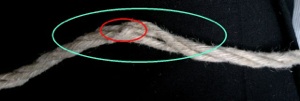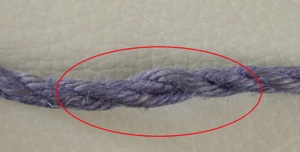High Stranding


As a finished rope is usually ended by knots, if the rope was made correctly, we must consider that each of the strands have an identical length and twist rate. However, as they get used, and sometimes not treated with the required care. it may happen that one or more strands appear to be shorter in some parts, and longer in others, as shown in the photo above. That problem is usually easily fixed, particularly when the problem is spotted early.
The possible approaches and techniques described in that section do take this into account; as a consequence, opening one rope end to “cut off the excess material” is to be avoided.
This being said, let’s look at what happens when the rope shows signs of high-stranding...
High stranding occurs when one or more strands skip rotations and leave their normal position in the laid rope.
Some examples:
For high-stranding repair techniques, click here





